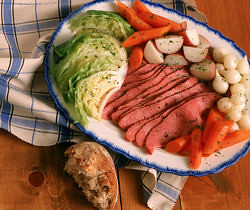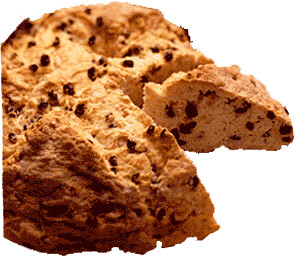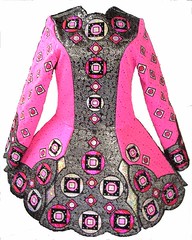Culture
From The Peopling of New York City: Irish Communities
Culture: | St. Patrick |
Irish Culture is expressed in New York City through the celebration of the Irish patron saint, St. Patrick. The day where the parade and cathedral honor St. Patrick are vital parts of the Irish experience and community. One of the most important and well-known events in Irish Culture is the celebration of the St. Patrick's Day Parade, a representation of Irish pride. On this day many Irish cultural practices such as Irish step dancing and the playing of Irish bagpipes are carried out, and cultural foods are served in restaurants all over the city.
Irish Foods
Potatoes, Soda bread, corn beef and cabbage are only a few traditional Irish foods that are eaten in the United States. Irish foods are especially served on St. Patrick's Day. In a traditional house-hold for thousands of years their diet consisted of grain based, mainly oats and barley, generally eaten in the form of porridge but also ground into flour in later years to use for bread. It was the most important part of the diet of both rich and poor.
Meat was important at some periods of history but not always. There are periods when farming seems to concentrate on crop production and during these times animals such as cattle and sheep would mainly have been kept for milk production and the making of cheese or curds, a common food.
At other times, little farming of crops took place and people ate a lot of meat, both from animals kept for the purpose and wild animals. Birds, wild boar and goats, deer and even hedgehogs were commonly eaten. Meat was always more commonly eaten by the better off rather than the poor.
By the start of the 16th century there were areas of the country mainly devoted to producing grain crops and others where the production of meat was more important, depending on the type of land. Farmers sold their produce and livestock at local markets, directly to householders or to agents who took it to the larger towns. In many cases they were required to sell exclusively to their landlord and at fixed prices, frequently well below the market rate.
Dance
Irish step dancing has become a major and well known practice of Irish culture in the United States. Particularly in New York, there are many dance Institutions that offer the teaching of this old-style dancing.
Irish dance is no less culturally significant. Being closely connected to Irish music, it followed a similar pattern of cultural recognition in the United States. It has existed in America for as long as there have been Irish immigrants, and while it has been popular locally, it has only gained widespread attention recently, with the help of Broadway shows like 'Riverdance'. Much like Gaelic music, it too evolved and melded with other styles of dance, but preserving the traditional forms of step-dance has always been important for Irish Americans. Within the New York area, there are several dance studios dedicated to teaching both traditional, and fusion style step-dance to immigrant and non-Imigrant alike. The preservation of these forms of dance, along with their thriving fusion, is a great example of how Irish culture can readily assimilate with American culture, and yet still retain a strong Gaelic flair, that makes it quite unique.
Irish performance dancing is traditionally referred to as step-dance. Irish step-dance, popularized in 1994 by the world-famous show "Riverdance," is notable for its rapid leg movements, body and arms being kept largely stationary. Most competitive step-dances are solo dances, though many step-dancers also perform and compete using traditional set and céilí dances. The solo step-dance is generally characterized by a controlled but not rigid upper body, straight arms, and quick, precise movements of the feet.
The tradition of step dancing in Ireland grew from an indigenous form of percussive dance that developed alongside traditional Irish music. The current incarnation of this tradition is known as sean-nós dancing (damhsa ar an sean-nós or rince sa sean-nós). The strongest tradition of sean-nós dancing (which means old-style) persists in the Connemara Gaeltacht in the West of Ireland, although sean-nós dancers can be found throughout Ireland.
Music
Irish culture has always had strong ties to song and dance, and coming to the America has not changed this. While these forms of entertainment and art have changed over the years, they all still retain a parts of Gaelic culture, which have assimilated with our own. Irish music has a long history in United States influencing many styles of folk and country music as they were being developed. Traditional Gaelic music gained notoriety on its own in the early 20th century, and became more and more popular as time went on, fusing with Rock and Roll, and New Age styles. The more recent wave of Irish immigration in the late 20th century gave rise to a popularization of Celtic rock, which began in small venues in Irish neighborhoods (still popular venues today). These Irish American bands would commonly use old Irish folk music as influence for their songs, using instruments like the accordion and violin along with the electric guitar and base, in a compelling example of cultural fusion.



